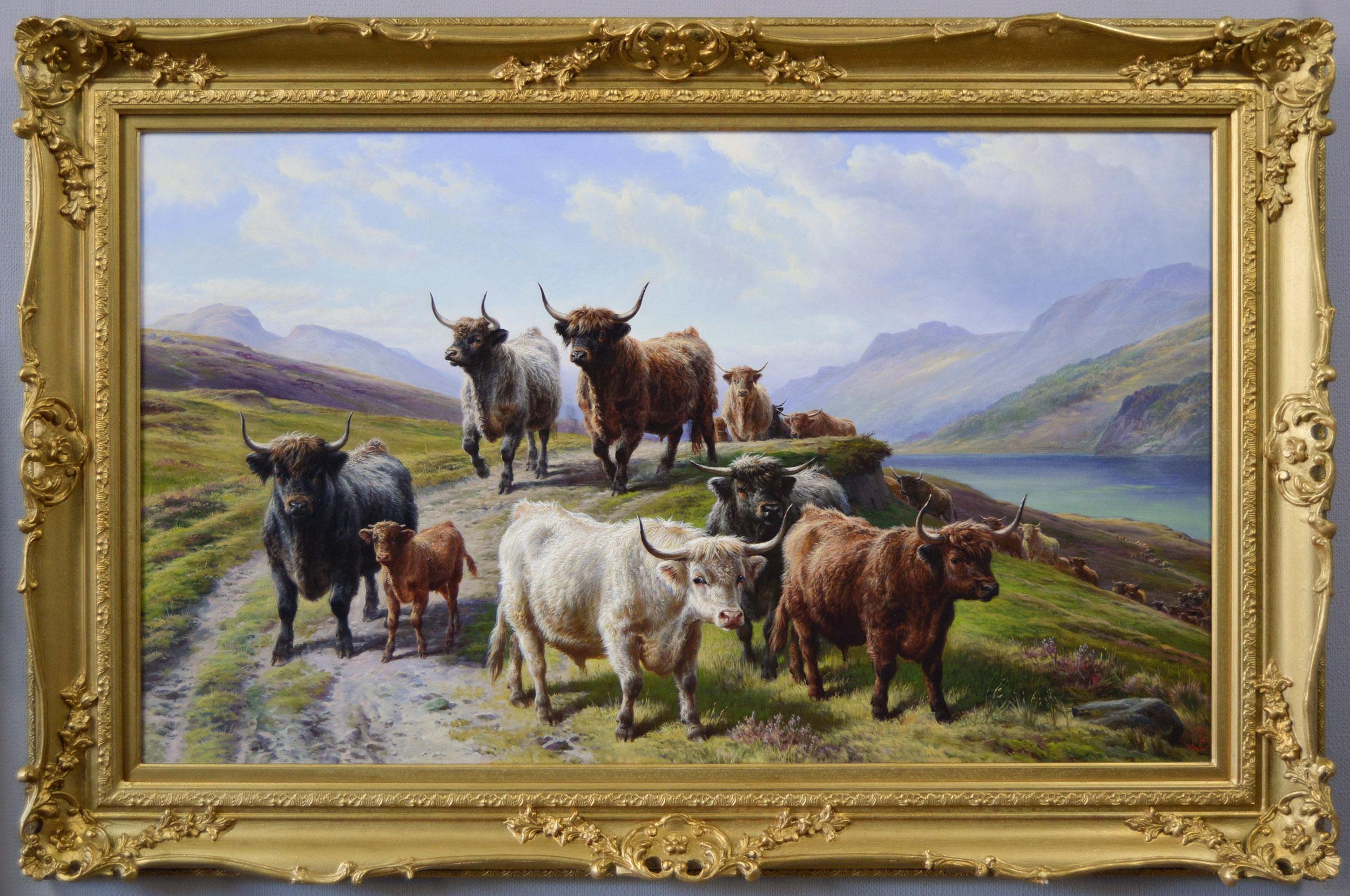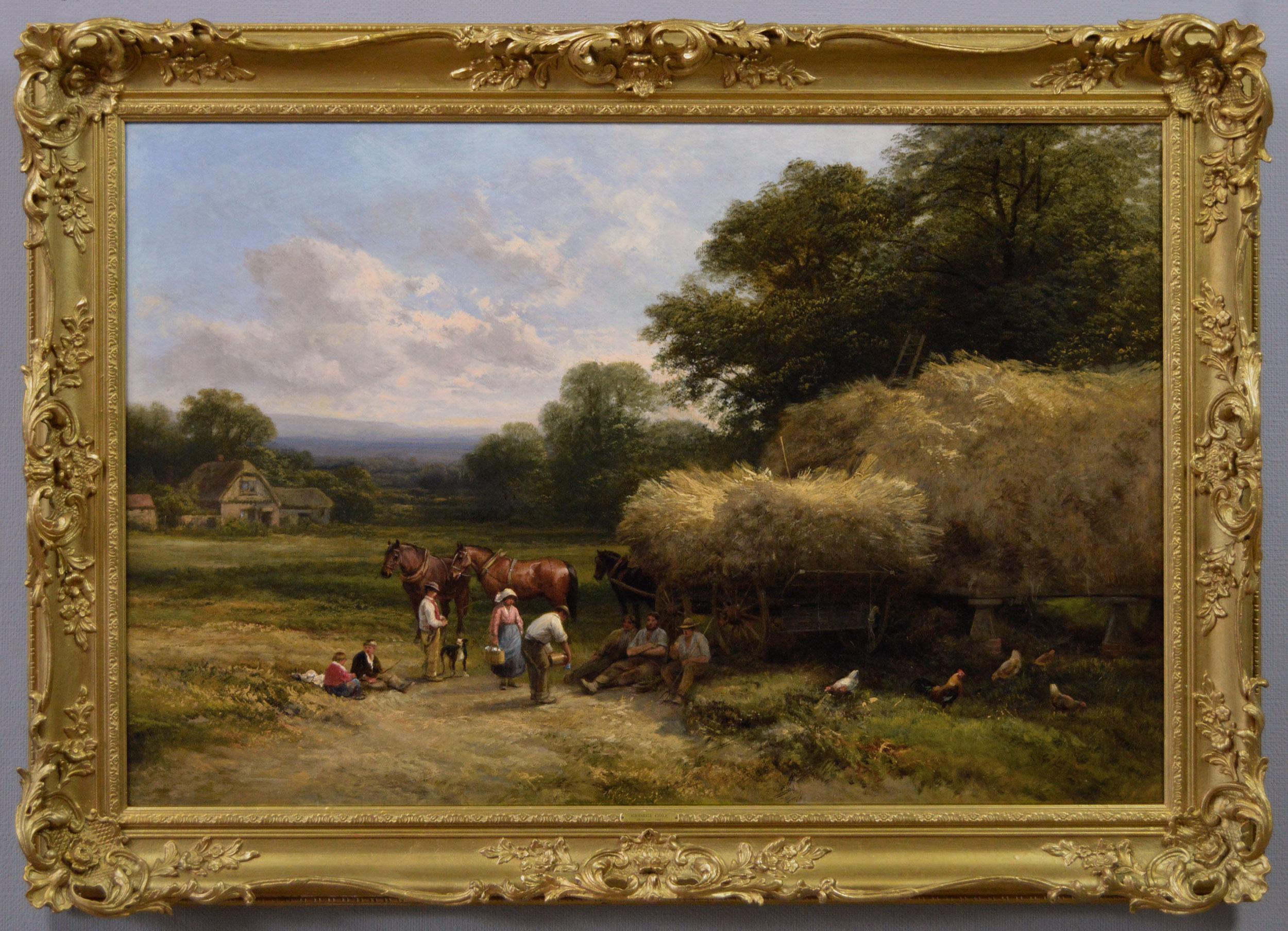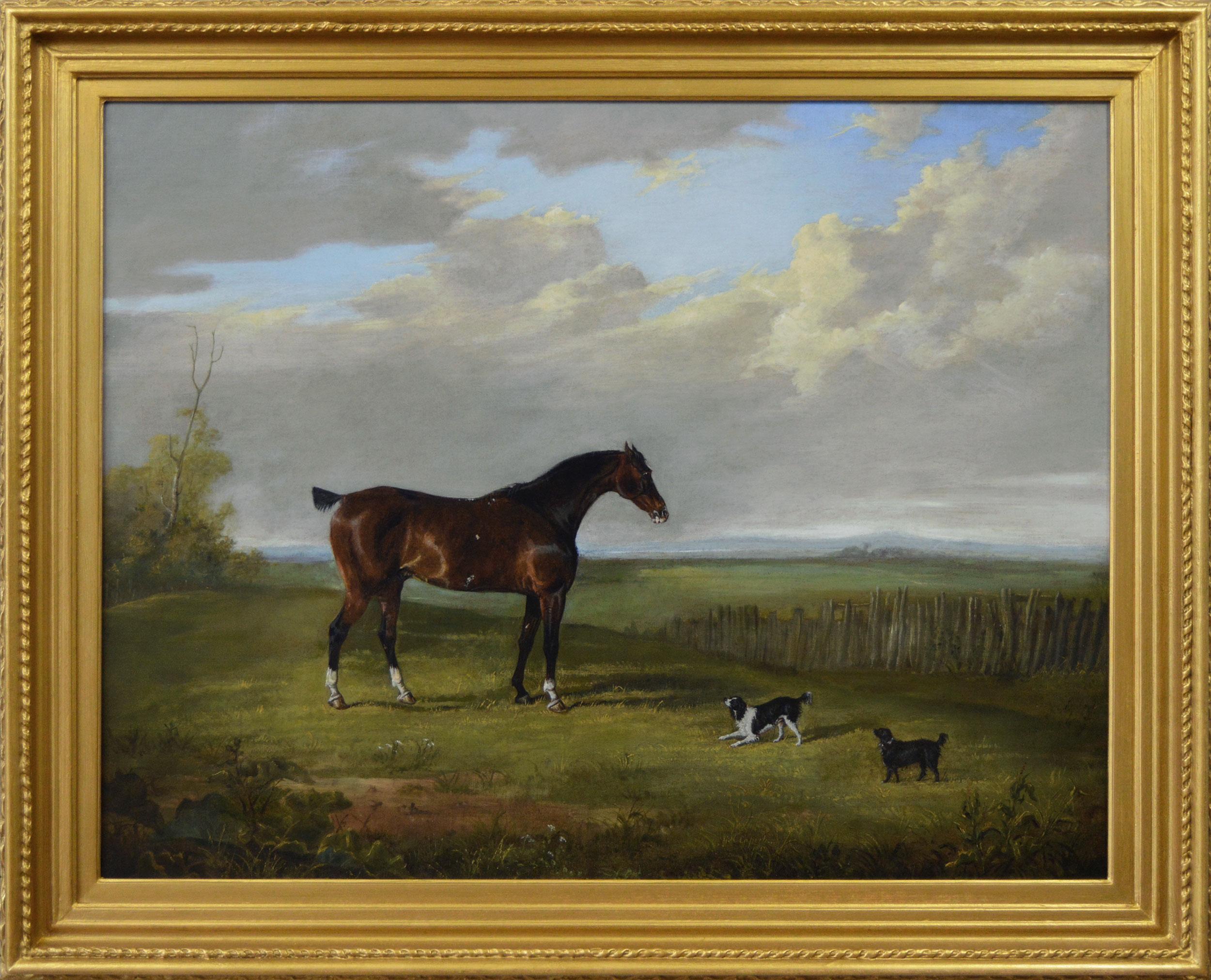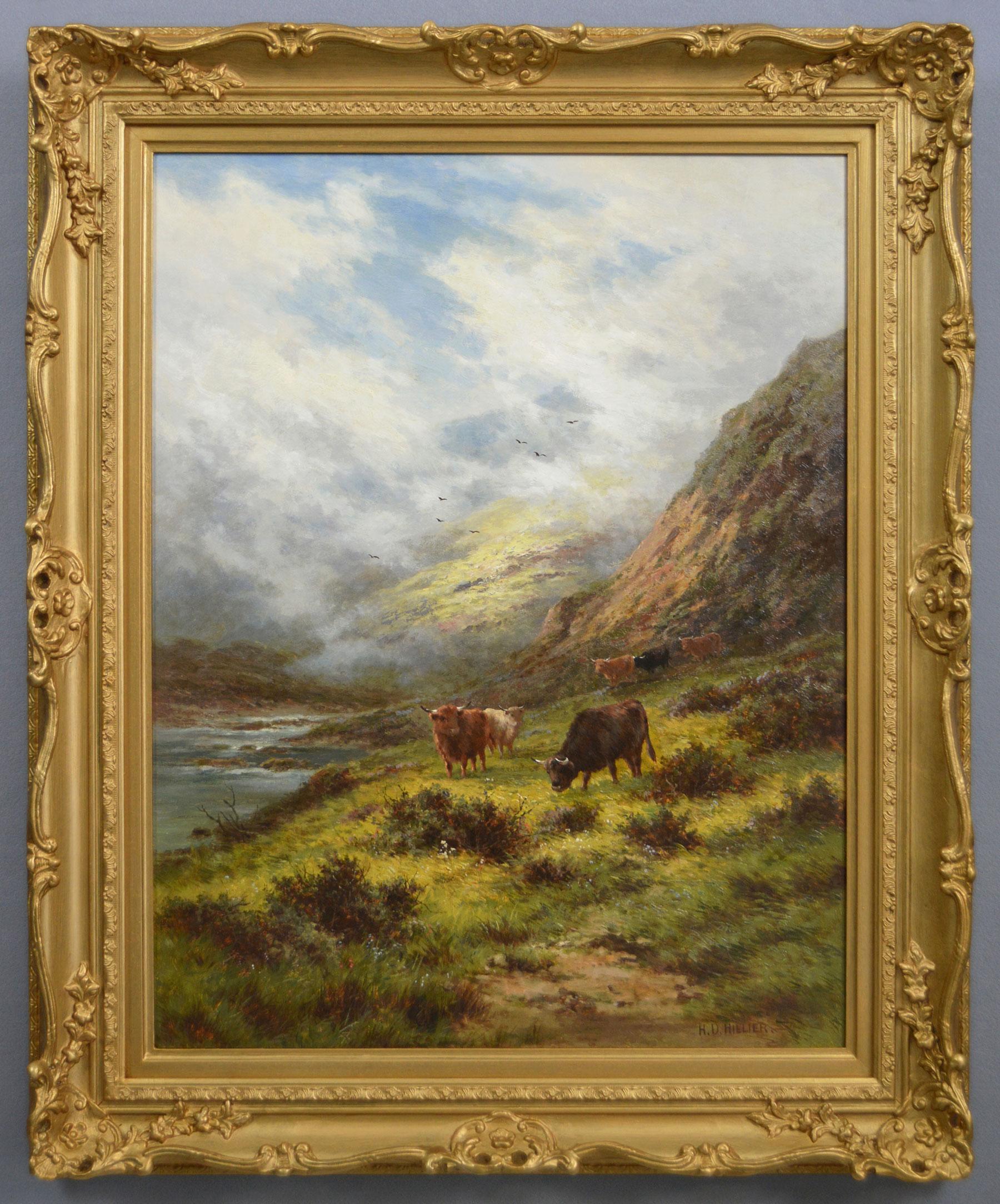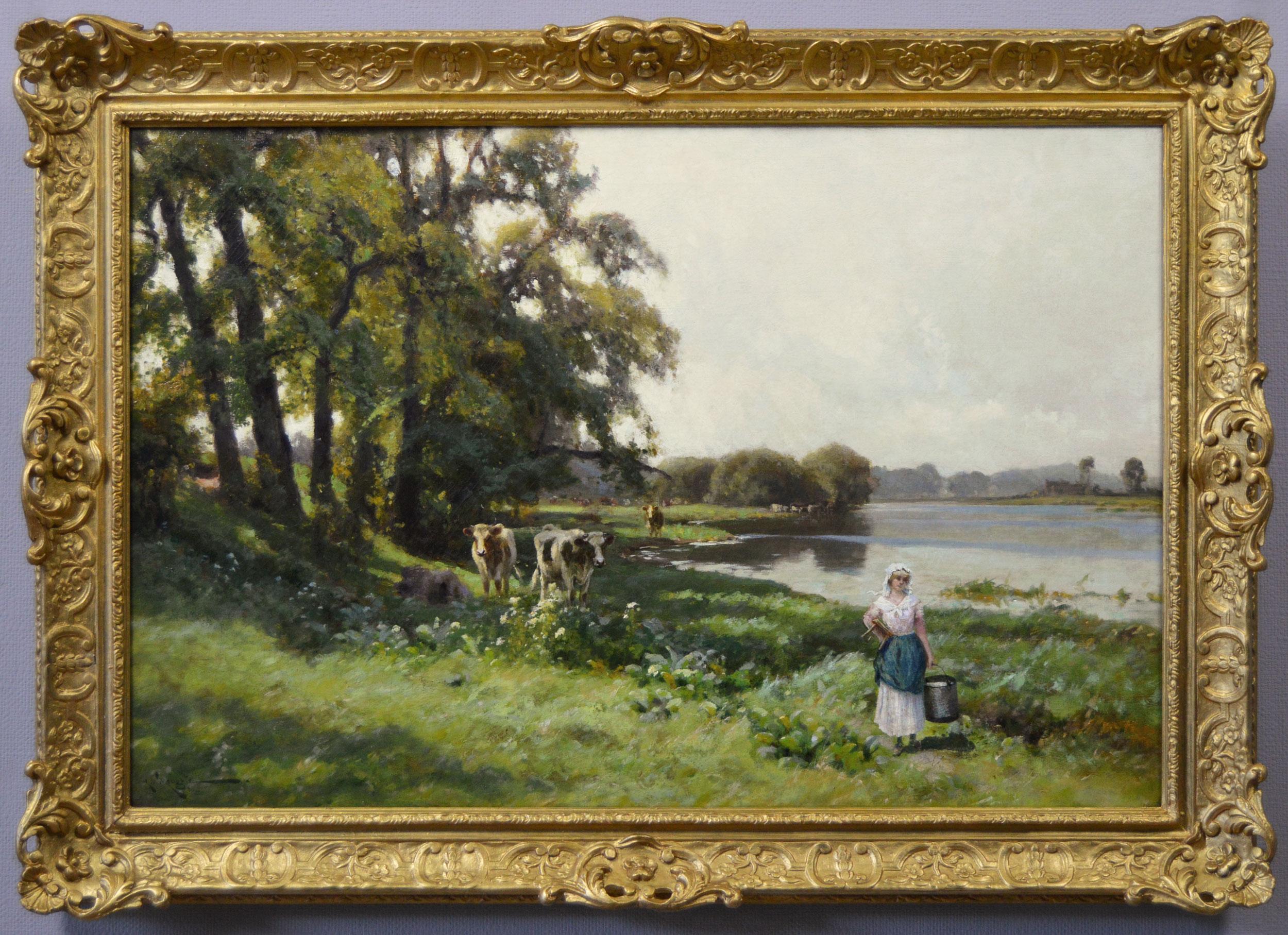Items Similar to 19th Century landscape animal oil painting of cattle & sheep by a river
Want more images or videos?
Request additional images or videos from the seller
1 of 13
Thomas Sidney Cooper19th Century landscape animal oil painting of cattle & sheep by a river1894
1894
About the Item
Thomas Sidney Cooper
British, (1803-1902)
Canterbury Meadows
Oil on canvas, signed & dated ‘T. Sidney Cooper RA/1894
Image size: 14.75 inches x 24.75 inches
Size including frame: 21.5 inches x 31.5 inches
Thomas Sidney Cooper was born in St Peter’s Street, Canterbury on 26 September 1803 to William and Sarah Cooper. He was christened Thomas Cooper and at some point adopted Sydney or Sidney as his middle name. At the age of 12 he started working as a coach painter and later a scene painter, continuing to draw and paint in his spare time.
When he was 21 he was helped by his uncle to move to London and study at the Royal Academy. However, he didn’t complete the course and returned to Canterbury. Shortly afterwards in 1824, he travelled to Brussels where he met Eugène Joseph Verboeckhoven who had a great influence on his work. He also met and married Charlotte Pearson the daughter of a mathematician. After the revolution broke out they returned to London in 1831 where Cooper started selling paintings of the cattle that he sketched at Smithfield Market. The couple lived at Portland Terrace, St John’s Wood and together had four children. His son Thomas George Cooper (1836-1901) became an artist and also his great nephew William Sidney Cooper (1854-1927) both of whom he taught.
In 1833 he made his debut at the Royal Academy, where he continued to exhibit regularly until his death. He also exhibited at the Royal Society of British Artists and the British Institution between 1833 and 1863. He was elected ARA in 1845 and RA in 1867. From the early 1840’s he lived at 16 Wellington Terrace, until the 1850’s when he moved to 2 Dorset Square, Regent’s Park. He continued to live there for over 10 years until he moved to 42 Chepstow Villas, Bayswater. Around 1849, he had a second house built in Harbledown, Canterbury and named it Vernon Holme after his patron and from where he would also paint and exhibit.
Cooper specialised in paintings of cattle or sheep, which earned him the nickname of 'Cow Cooper'. He became one of the most accomplished and successful animal landscape painters of the 19th century. He built Alms Houses in Canterbury and in 1882 set up the Canterbury Sidney Cooper School of Art. In July 1901, he was awarded the Commander of the Royal Victorian Order (CVO). Cooper died at Harbledown, Canterbury on 7 February 1902 and was buried at St Martin Churchyard.
Examples of his work can be found at the Royal Museum in Canterbury, Tate Gallery, Victoria and Albert Museum, Atkinson Art Gallery, Birmingham Museum, Brighton and Hove Museum, Northampton Museum Sheffield Museum and other public collections.
Canterbury Meadows was a subject he painted on many occasions and would have known very well. With the River Stour running through it, the location provided local farmers with the ideal grazing ground and watering for their cattle and sheep. The church in the distance with its distinctive spire is most likely to be the church of St Mary the Virgin at Fordwich which still stands today.
Presentation: The painting is housed in a new, English made gilt frame which is in excellent condition.
Condition: As with all of our original antique oil paintings, this work is offered in ready to hang gallery condition, having just been professionally cleaned, restored and revarnished.
© Benton Fine Art
- Creator:Thomas Sidney Cooper (1803 - 1902, British)
- Creation Year:1894
- Dimensions:Height: 21.5 in (54.61 cm)Width: 31.5 in (80.01 cm)Depth: 3 in (7.62 cm)
- Medium:
- Movement & Style:
- Period:
- Condition:
- Gallery Location:Moreton-In-Marsh, GB
- Reference Number:1stDibs: LU15627303022
About the Seller
4.9
Platinum Seller
These expertly vetted sellers are 1stDibs' most experienced sellers and are rated highest by our customers.
Established in 1972
1stDibs seller since 2015
271 sales on 1stDibs
Typical response time: <1 hour
Associations
The British Antique Dealers' AssociationLAPADA - The Association of Arts & Antiques DealersInternational Confederation of Art and Antique Dealers' Associations
- ShippingRetrieving quote...Ships From: Moreton-In-Marsh, United Kingdom
- Return PolicyA return for this item may be initiated within 3 days of delivery.
More From This SellerView All
- 19th Century Scottish landscape oil painting of Highland cattle at Loch LinnheBy Charles Jones (b.1836)Located in Moreton-In-Marsh, GloucestershireCharles Jones British, (1836-1892) Highland Cattle by Loch Linnhe Oil on canvas, signed with monogram & dated (18)87, inscribed verso Image size: 23.25 inc...Category
19th Century Victorian Animal Paintings
MaterialsCanvas, Oil
- 19th Century pair of river landscape oil paintings with cattleBy Henry H. ParkerLocated in Moreton-In-Marsh, Gloucestershire**PLEASE NOTE: EACH PAINTING INCLUDING THE FRAME MEASURES 17.5 INCHES X 23.5 INCHES** Henry H Parker British, (1858-1930) The River Wey near Ripley, Surrey & At Culham on Thames O...Category
19th Century Victorian Landscape Paintings
MaterialsOil, Canvas
- 19th Century landscape genre oil painting of farmworkers with horses & a dogBy George ColeLocated in Moreton-In-Marsh, GloucestershireGeorge Cole British, (1810-1883) Rick Making, Lunchtime Oil on canvas, signed & dated 1883 Image size: 23.5 inches x 35.5 inches Size including frame: 30.5 inches x 42.5 inches Prove...Category
19th Century Victorian Animal Paintings
MaterialsCanvas, Oil
- 19th Century sporting horse portrait oil painting of a racehorse with spanielsBy George Henry LaporteLocated in Moreton-In-Marsh, GloucestershireGeorge Henry Laporte British, (1802-1873) Best of Friends Oil on canvas, signed & indistinctly dated Image size: 27.25 inches x 35.25 inches Size...Category
19th Century Victorian Animal Paintings
MaterialsCanvas, Oil
- 19th Century Highland landscape oil painting of cattle by a loch near KillinLocated in Moreton-In-Marsh, GloucestershireHenry Deacon Hillier British, (1858-1930) Near Killin, Perthshire Oil on canvas, signed, inscribed verso Image size: 27.25 inches x 21.25 inches Size including frame: 35 inches x 29...Category
19th Century Victorian Landscape Paintings
MaterialsOil, Canvas
- 19th Century landscape oil painting of a woman with cattle near a riverLocated in Moreton-In-Marsh, GloucestershireArthur Walker Redgate British, (1860-1906) On the Tow Path by the Trent Oil on canvas, signed Image size: 19.25 inches x 29.25 inches Size including frame: 25 inches x 35 inches Pro...Category
19th Century Victorian Landscape Paintings
MaterialsOil, Canvas
You May Also Like
- Alfred Walter Williams, Barmouth Sands, North Wales, Oil PaintingLocated in Cheltenham, GBThis late 19th-century oil painting by British artist Alfred Walter Williams (1824-1905) depicts an expansive view across Barmouth Sands in North Wales. The relaxed golden sands str...Category
1880s Victorian Landscape Paintings
MaterialsCanvas, Oil
- The Fox and Cubs In Woodland Signed British Oil PaintingLocated in Cirencester, GloucestershireAlan King, British Artist (1946- 2003) signed oil on canvas, framed framed: 27 x 37 inches canvas: 20 x 30 inches provenance: UK collection The painting is ...Category
20th Century Victorian Landscape Paintings
MaterialsCanvas, Oil
- Large French Oil Painting Two Horses in Landscape Grey and Chestnut framedLocated in Cirencester, GloucestershireHorses Standing in Landscape French School, 20th century oil on canvas, framed framed: 25 x 34 inches canvas: 19.5 x 30 inches provenance: private collection, France condition: very ...Category
20th Century Victorian Animal Paintings
MaterialsCanvas, Oil
- Large Victorian Scottish Oil Painting Glencoe Mountains with Shepherd & SheepLocated in Cirencester, GloucestershireGlencoe Scottish School, late 19th century indistinctly signed lower corner signed oil painting on canvas, framed framed: 30.5 x 42 inches canvas: 24 x 36 inches provenance: private...Category
Late 19th Century Victorian Landscape Paintings
MaterialsOil, Canvas
- Fine Victorian Signed Oil Painting Pastoral Landscape with Sheep Brooding SkiesLocated in Cirencester, GloucestershirePastoral Landscape with Sheep by J. Morris, British 19th century signed oil on canvas, framed framed: 15 x 23 inches canvas: 12 x 20.75 inches provenance: private collection, UK cond...Category
Late 19th Century Victorian Animal Paintings
MaterialsCanvas, Oil
- Beautiful Victorian English Rural Oil Painting Thatched Cottage Animals by PondLocated in Cirencester, GloucestershireThe Thatched Cottage Suffolk School, 19th century indistinctly signed & dated verso oil on canvas, unframed canvas: 13 x 19 inches provenance: private collection, England condition: ...Category
19th Century Victorian Landscape Paintings
MaterialsCanvas, Oil
Recently Viewed
View AllMore Ways To Browse
Antique Animal
Oil Painting Thomas
Thomas Oil Painting
Artist Cooper
Animals On Stand
1894 Painting
19th Century Painting With A River
Sheep Painting
10 X 7 Painting
Cattle Painting
Painting With Sheep
21st Century Sketch Gallery
Paintings Of Cattle
19th Century Paintings Of Children
Oil Paintings Signed Thomas
Antique Wood Animal
Paintings With Cattle
Selling Antique Paintings
